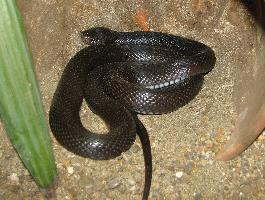
Weights and measures
| Length | 150 cm |
|---|
Animal description
The Red Spitting Cobra, scientifically known as Naja pallida, is a fascinating and formidable species of venomous snake belonging to the Elapidae family. This species is renowned not only for its striking appearance but also for its unique defensive mechanism of spitting venom. Predominantly found in the arid regions of sub-Saharan Africa, it thrives in a variety of habitats including savannas, arid grasslands, and semi-deserts, demonstrating a remarkable adaptability to different environmental conditions.The Red Spitting Cobra exhibits a slender and agile physique, with adult specimens typically reaching lengths of about 0.9 to 1.2 meters, although some individuals may grow larger. The snake's name is derived from its distinctive coloration; its body is primarily a vibrant reddish or pinkish hue, with shades varying among individuals from bright red to orange, pink, or even pale brown. The belly is usually lighter, and the snake may display a distinctive dark band around the throat, adding to its striking appearance.
One of the most remarkable features of the Red Spitting Cobra is its ability to defensively project venom from its fangs towards perceived threats. This specialized behavior is an evolutionary adaptation aimed at deterring predators without engaging in direct physical confrontation. The cobra can accurately spit its venom at a distance of up to 2.5 meters (about 8 feet), targeting the eyes of its aggressors. The venom is not lethal when it comes into contact with intact skin but can cause severe pain, inflammation, and temporary or permanent blindness if it enters the eyes. This mechanism serves as an effective deterrent, allowing the cobra to escape potential harm.
The venom of the Red Spitting Cobra is neurotoxic, affecting the nervous system of its prey, which includes small mammals, birds, amphibians, and occasionally other snakes. When hunting, the cobra relies on its keen sense of sight and chemical reception to locate prey, striking with precision and envenomating it. The neurotoxins in the venom quickly immobilize the prey, facilitating ingestion.
Reproduction in Red Spitting Cobras is oviparous, meaning they lay eggs. Females typically lay clutches of 10 to 20 eggs, which they may guard fiercely until they hatch. The hatchlings are independent from birth and possess venom as potent as that of the adults, making them capable of fending for themselves almost immediately.
Despite its venomous capabilities and aggressive reputation, the Red Spitting Cobra plays a crucial role in its ecosystem by controlling the populations of the small animals it preys upon. However, like many other species, it faces threats from habitat destruction and persecution due to fear and misunderstanding of its nature. Conservation efforts are essential to ensure the survival of this remarkable species, emphasizing the importance of habitat preservation and education to reduce human-snake conflicts.
In conclusion, the Red Spitting Cobra is a captivating creature, embodying the beauty and complexity of the natural world. Its unique adaptations, striking appearance, and role in the ecosystem make it a subject of great interest and importance in the study of biodiversity and conservation.
Similar Animals
New photos of animals
Top 10 animals
- Dolphin gull (Leucophaeus scoresbii)
- Japanese macaque (Macaca fuscata)
- Stone loach (Barbatula barbatula)
- Greek tortoise (Testudo graeca)
- Diana monkey (Cercopithecus diana)
- Galápagos tortoise (Geochelone nigra complex)
- Russian tortoise (Testudo horsfieldii)
- Moustached guenon (Cercopithecus cephus)
- Galápagos penguin (Spheniscus mendiculus)
- Common flying dragon (Draco volans)


